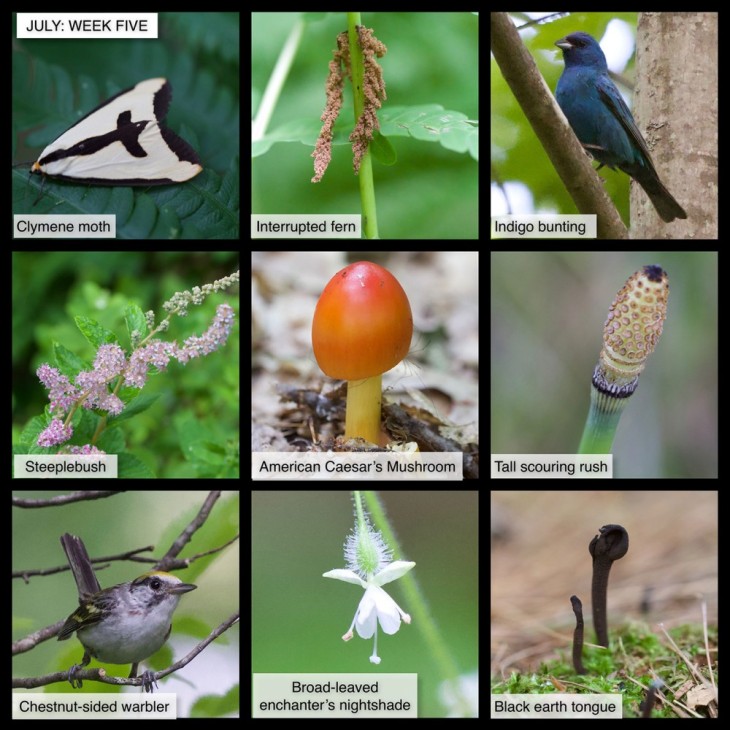This Week in the Woods, we’ve had several encounters with clymene moths. According to the National Wildlife Federation’s Field Guide to Insects and Spiders of North America, this species is associated with wetlands and waterways. That said, it appears to be very adaptable; it has a wide range (Florida to Quebec) and we found it in sunny fern patches, high up in dry woodlands. This beautiful moth with a cross on its back has several host plants in our region, including oaks. Here’s a link from Bugguide.net with more images.
We’re always grateful for easy-to-identify ferns, and interrupted fern is on that list. This time of year, look for the light brown clumps partway up fronds – these are fertile leaflets that produced spores in early summer. They’re now darkening and will eventually fall off the fronds. Here’s a profile from the Friends of the Wild Flower Garden (Eloise Butler Wildflower Garden and Bird Sanctuary), with photos showing the development of the fertile leaflets (pinnae).
Most blue animals, including male indigo buntings, owe their hue to structural coloration. As the Vermont Center for Ecostudies’ Steve Faccio explains in this Outside Story essay, “the intense blue that we perceive is due to the microscopic structure of its feathers and the way they reflect blue and violet light.” Inhabitants of shrubby areas and woods edges, indigo buntings are relatively common birds that have adapted well to human impacts on the landscape, and they may be expanding their range due to climate change. As their thick bills indicate, they’re frequent seed eaters, although they also feed on berries, insects, and spiders. Here’s a profile from Audubon, and a map from the Forest Service’s Climate Change Atlas, with tabs on the top for current and projected ranges.
Steeplebush is blooming. It grows at the edge of wetlands and in other damp places such as seeps in meadows – and sometimes in places it seems unlikely there’s any moist soil at all. It’s also called rosy meadowsweet. There are no doubt more elegant ways to describe them, but the blossoms look like bumpy cotton candy, or pink Muppet fuzz. Here’s a profile from The Native Plant Trust.
American Caesar mushrooms are fruiting now through September. These mushrooms in the genus Amanita are big (stems may grow nine inches high) with gorgeous blaze orange caps that start off looking like giant eggs. Mary Holland has photographed and written about them for her Naturally Curious blog.
If you have any dinosaur fans in your life, consider a scouting expedition for scouring rush, also called horsetail or equisetum. The fossil records for these plants stretch back at least 150 million years, which means that they’re excellent fodder for a toy Apatosaurus. Here’s an article describing research on early fossils, and a profile for the species in this week’s photo grid, tall scouring rush, which we found growing at the edge of a pine woods. As noted by The Native Plant Trust profile, the plant’s high silica content made it historically useful for “polishing or scouring metal, pewter and wood.”
The fledgling parade continues, providing perhaps the best opportunity all summer to see and photograph songbirds. This week, we encountered young chestnut-sided warblers, which (like the indigo bunting discussed above) thrive in shrubby habitat. Here’s a brief YouTube video from the Cornell Lab of Ornithology, showing a bird giving its familiar “pleased pleased pleased to meetya” call. And here’s a profile of the species.
Remember those tiny, sticky round green balls that coat your clothing in late summer? They’re the fruit of broad-leaved enchanter’s nightshade, which is one of the few flowers blooming now in the woods. Here’s a profile from The Native Plant Trust. Note: there is also another, similar-looking species in our region, smaller enchanter’s nightshade; one distinctions is that the flower stalks of broad-leaved enchanter’s nightshade tend to spread out at a more-or-less right angle from the stem.
There are multiple species of black earth tongue, a fungus that often pops up on old, mossy logs and stumps. Here’s a link with more images from the Maryland Biodiversity Project.
In this difficult period, many of us find joy in observing local nature, and many families are seeking outdoor enrichment opportunities for children. Here are nine photographs taken this past week, most within 15 miles of the Northern Woodlands office in Lyme, New Hampshire. We hope you enjoy using this grid as a prompt for your own explorations, or as the basis for a game of family forest tic-tac-toe.
What are you seeing in the woods this week? Share your images with us on Facebook, or submit a special photo for possible inclusion in our monthly online Reader Photo Gallery.


